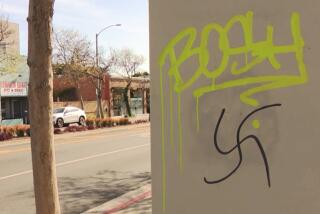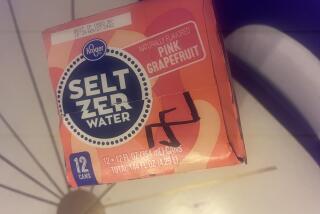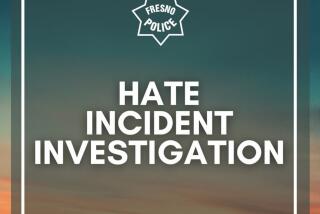New York City sees surge of swastika vandalism since the election

The appearance of swastikas all over New York is causing special concern in one of the nation’s most heavily Jewish cities.
Lisa Wolford picked up her 8-year-old twins at school Friday afternoon and had some time to kill before rehearsals for their Christmas pageant, so she brought them to the little playground near her apartment. They were in for a nasty surprise.
To her horror and the confusion of her children, somebody had spray-painted on the jungle gym something she would have never expected to see in Brooklyn Heights, especially not in this secluded neighborhood park: a pair of swastikas.
“It was surreal to see these children playing and laughing with the backdrop of the swastika,’’ said Wolford, 48. “I felt sick to my stomach.”
There have been 14 instances of swastika vandalism in New York City since the election, eight of them in the last week alone, according to press reports and the New York Police Department. No arrests have been made, the police said. By way of comparison, last year there were about five to six incidents per month.
Civil rights groups attribute the proliferation of the Nazi symbol to the triumphal mood of white nationalists who had supported president-elect Donald J. Trump in the Nov. 8 election. In the incident last week in Brooklyn, the vandals had also scrawled “Go Trump” and other graffiti near the swastikas.
The incidents in New York run parallel with a surge in reports of hate crimes and racist graffiti around the United States. The FBI reported a 6% increase in hate crimes in 2015 from the year before, with most of the increase attributable to harassment of Muslims. These incidents are especially shocking to New Yorkers, who pride themselves in the diversity of a city whose harbor is watched over by the Statue of Liberty. New York is also home to roughly 1.1 million Jews, more than any other city outside of Israel.
The Southern Poverty Law Center last week reported 701 incidents of harassment since election day, including 60 acts of vandalism involving the swastika.
Similar graffiti was reported Sunday on a New York City subway car; somebody had used a permanent marker to draw a swastika on a seat and “Trump 2016” over a subway map. Swastikas unaccompanied by references to the election were also found over the last two weeks in the dormitories of the New School, a progressive college famous for welcoming Jewish intellectuals fleeing Europe after World War II, and outside a synagogue in Crown Heights in Brooklyn.
Swastikas were carved into the elevator doors in the Greenwich Village apartment building of Brad Hoylman, an openly gay and Jewish state senator last week. He also received an anti-Semitic pamphlet in his mailbox on Saturday with the warning, “False religious orders must perish…. That goes for Judaism.’’
Hoylman lays the blame on Trump’s election and the appointment last week of Steve Bannon as his strategic advisor. Bannon was formerly the executive chairman of Breitbart News, which became a purveyor of white supremacist “alt-right” ideology in recent years.
“That was an earthquake moment in American politics and the aftershock is something we are experiencing in the form of bias, harassment and hate crimes and a refusal by the president-elect to disavow his neo-Nazi, white nationalist sympathizers,’’ said Hoylman.
When asked about neo-Nazi supporters in a meeting with the New York Times on Tuesday, Trump said he disavows and condemns them. “It’s not a group I want to energize,” he said.
Trump has otherwise spoken little about the hate speech incidents since the election. In one interview with CBS’ Lesley Stahl, who asked him directly about attacks on Muslims and Latinos, he said, “I will say right to the cameras: ‘Stop it.’” He did not elaborate further.
Trump’s son-in-law, Jared Kushner, an Orthodox Jew, has repeatedly defended his father-in-law against accusations of anti-Semitism, most recently in an interview with Forbes in which he said “if the country gives him a chance, they’ll find he won’t tolerate hateful rhetoric or behavior.”
The swastika, adopted by the Nazis from an ancient religious symbol found in Hinduism and Buddhism, has become so tarnished by its association with the Holocaust that its public display is banned in many parts of the world. There is no outright ban in the United States, but in New York state its use in graffiti elevates what would normally be a misdemeanor vandalism charge to aggravated harassment, a felony.
Melissa Garlick, civil rights counsel for the northeast region for the Anti-Defamation League, says that 45 states have similar laws that deem use of the swastika to be a hate crime.
“The swastika is typically associated with anti-Semitism and persecution of Jews during World War II, but we call it an equal-opportunity hate symbol… in that it is used as a universal symbol of hate to instill fear and intimidation,” said Garlick.
At the Brooklyn playground, Wolford said her twins recognized the word “Trump” scrawled on the jungle gym, but not the swastika. “I had to give them a little history lesson later,” she said.
Wolford, a corporate communications executive, immediately took a photograph with her smartphone and distributed it to friends through social media. Within minutes, the photograph went viral and the New York police dispatched their hate crimes unit to investigate. By 9 p.m. that night — about four hours after Wolford sent out the photos — the graffiti had been painted over.
Over the weekend, children put flowers and heart-shaped decals on the jungle gym at the small park named for Adam Yauch, the musician who founded the Beastie Boys and who died of cancer in 2012. By Sunday, the neighborhood had organized an anti-hate speech rally that attracted close to 1,000 people. The crowd included Beastie Boys member Adam “Ad-Rock” Horovitz and actor Ben Stiller, as well as city and state officials, representatives from Brooklyn’s various ethnic communities, rabbis and imams.
“It was an amazing event where you really saw the diversity of the city on display,” said Jonathan Kopp, Wolford’s neighbor and an organizer of the rally.
Paraphrasing one of the imams who spoke at the rally, he said the graffiti had succeeded in one thing: “unifying Jews and Muslims.”
More to Read
Start your day right
Sign up for Essential California for news, features and recommendations from the L.A. Times and beyond in your inbox six days a week.
You may occasionally receive promotional content from the Los Angeles Times.






